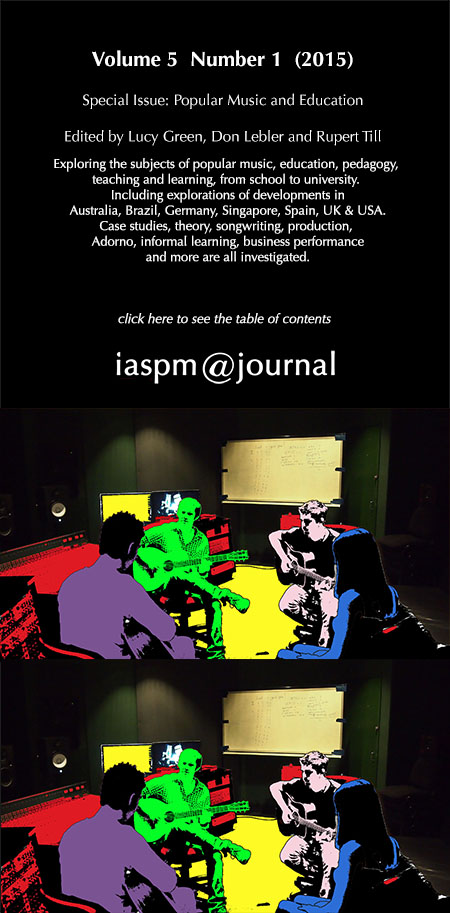Creative Conceptualisation: Nurturing Creative Practice Through the Popular Music Pedagogy of Live Recording Production.
DOI:
https://doi.org/10.5429/ij.v5i1.711Keywords:
record production, popular music pedagogy, live recordingAbstract
Record production is a major aspect of many tertiary-based popular music education programs. It is a practice that involves the capturing of an artist’s vision and is realised when that vision draws an emotional response from the listener. In professional practice there are many techniques the producer learns via experience to accomplish this, but as technology develops, processes of past eras risk being brushed aside by technological advancement. The capturing of a live performance was the practical framework used by popular music pioneers and the creative results of this process have particular characteristics that are difficult to achieve by contrasting methods. This article outlines the importance of an education in live recording frameworks to tertiary popular music students; it presents learning and teaching practices that accomplish this and concludes with a case study of a live recording workshop that nurtures the students’ developing creative practice.References
Biggs, J. and Tang, C. 2007 Teaching for Quality Learning at University. 3rd edition. Berkshire: Open University Press.
Brook, A. 2009. The Potentiality of Authenticity in Becoming a Teacher. Educational Philosophy and Theory 31 (1): 46–59.
Burnard, P. 2007. Reframing Creativity and Technology: Promoting Pedagogic Change in Music Education. Journal of Music, Technology and Education 1 (1): 37–55.
Buskin, R. 1999. Inside Tracks: A First-hand History of Popular Music from the World’s Greatest Record Producers and Engineers. New York: Avon Books, Inc.
Claxton, G. 1997. Hare Brain Tortoise Mind. London: Fourth Estate Limited.
Csikszentmihalyi, M. 1996. Creativity: The Psychology of Discovery and Invention. New York: Harper Collins.
Farinella, D. J. 2006. Producing Hit Records: Secrets from the Studio. New York: Music Sales Corporation.
Folkestad, G. 2006. Formal and Informal Learning Situations or Practices vs. Formal and Informal Ways of Learning. British Journal of Music Education 23 (2): 135-145.
Full Sail University. 2012. Grammy-Winning Mixer/Audio Engineer Chris Lord-Alge at Full Sail University. https://www.youtube.com/watch?v=BGUcBhbyoF4. Accessed: 5 March 2013.
Green, L. –
How Popular Musicians Learn: A Way Ahead for Musical Education. Surrey: Ashgate.
Popular Music Education in and for Itself, and for “Other” Music: Current Research in the Classroom. International Journal of Music Education 24 (2): 101–118.
Lebler, D. −
Personal Correspondence, May.
The Master-less Studio: An Autonomous Education Community. Journal of Learning Design 1 (3): 41-50.
Student-as-master? Reflection on a Learning Innovation in Popular Music Pedagogy. International Journal of Music Education 25 (3): 205-221.
McNiff, S. 1998. Trust the Process: An Artist’s Guide to Letting Go. Boston: Random House.
May, R. 1975. The Courage to Create. New York: W.W. Norton & Company, Inc.ù
Macedo, F. 2013. Teaching Creative Music Technology in Higher Education: A Phenomenological Approach. Journal of Music, Technology and Education 6 (2): 207–219.
Mixerman. 2010. Zen and the Art of Mixing. Milwaukee: Hal Leonard Books.
Moorefield, V. 2005. The Producer as Composer: Shaping the Sounds of Popular Music. Cambridge: MIT Press.
Young, Neil. 2014. Record! The Red Button’s Not That Scary. Guardian Music, 22 January. http://www.theguardian.com/music/musicblog/2014/jan/22/neil-young-record-red-button-transcript. Accessed: 10 February 2014.
Robinson, N., Bell, C. and Pogonowski, L. 2011. The Creative Music Strategy: A Seven-Step Instructional Model. Music Educators Journal 97 (50): 50-55.
Tharp, T. 2003. The Creative Habit: Learn It and Use It for Life. New York: Simon and Schuster.
Tolle, E. 2004. The Power of Now: A Guide to Spiritual Enlightenment. Novato: New World Library.
YouTube. 2012. Birdy – Live. http://www.youtube.com/watch?v=LRSmMv32m6U. Accessed: 25 March 2015.
YouTube. 2013. Dave’s Pawn Shop. http://www.youtube.com/watch?v=q1xDEDgQI18. Accessed: 25 March 2015.
Discography
Beatles, The. 1969. “Get Back” / “Don’t Let Me Down”, Apple, UK.
Foo Fighters, The. 2011. Wasting Light, RCA, USA.
Gotye. 2011. Making Mirrors, Eleven, Australia.
Winehouse, Amy. 2006. Back to Black, Island, UK.
Downloads
Published
Issue
Section
License
Authors retain copyright, while licensing their work under a Creative Commons Attribution-NonCommercial-ShareAlike 3.0 Unported License.





